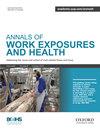128 评估美国工作场所多次接触化学品的潜在健康风险:来自 OSHA 数据库的发现
IF 1.8
4区 医学
Q3 PUBLIC, ENVIRONMENTAL & OCCUPATIONAL HEALTH
引用次数: 0
摘要
导言 职业暴露于多种化学品对健康的综合影响可能是巨大的。然而,对最常见的多重接触情况及其毒性影响的研究仍然不足。我们利用职业安全与健康管理局(OSHA)的测量数据库评估了美国工作场所多重接触化学品对健康造成的风险。方法 我们分析了 1971-2021 年期间按工作场所情况 (WS) 汇总的个人空气测量结果,工作场所情况与一年内对同一公司同一职位的测量结果相对应。我们通过将制剂浓度除以 ACGIH® 临界限值来计算危害商数 (HQ)。我们使用 MiXie 工具计算混合物的危害指数 (HI),方法是按 WS 和毒理学类别(n=24)组合计算药剂的 HQ,该工具可识别 700 种化学品的毒性效应类别。结果 我们从 162,473 个 WS 中提取了 206 种化学品的 609,233 个测量值。58,252个WS中的工人暴露于≥2种制剂,其中21,563人的HI>为1,表明至少有一种毒物类别暴露过度。在多重暴露的 WSs 中,HIs 最高的毒理学类别是下呼吸道损伤(中位数 0.41;四分位间 0.05-1.9;占过度暴露 WSs 的 35%)、耳毒性(0.28;0.04-1.1;26%)和中枢神经系统(CNS)损伤(0.26;0.02-1.2;28%)。在这三个类别中,最常导致高 HI 值的多重暴露分别是锰-氧化铁、甲苯-二甲苯和锰-铅。结论 虽然职业安全与健康管理局数据库并不一定代表美国工作场所的随机样本,但我们的方法提供了有关职业暴露于普遍化学混合物的健康风险的见解。本文章由计算机程序翻译,如有差异,请以英文原文为准。
128 Assessing potential health risks from multi-exposure to chemicals in U.S. workplaces: findings from the OSHA database
Introduction The combined effects of occupational exposure to multiple chemicals on health can be substantial. However, the most prevalent multi-exposure situations and their toxic effects remain understudied. We assessed the health risks from multi-exposure to chemicals in U.S. workplaces using the Occupational Safety and Health Administration’s (OSHA) measurement database. Methods We analysed personal air measurements for the period 1971-2021 summarized by workplace situation (WS), corresponding to measurements taken for the same job title, within a company, within a year. We calculated hazard quotients (HQ) by dividing the agents’ concentrations by their ACGIH® threshold limit value. We calculated the mixtures’ hazard indices (HI) by summing the HQs of agents by combination of WS and toxicological class (n=24) using the MiXie tool, which identifies classes of toxic effects for >700 chemicals. Results We extracted 609,233 measurements of 206 chemicals from 162,473 WSs. Workers in 58,252 WSs were exposed to ≥2 agents, of which 21,563 had an HI>1, indicating overexposure for at least one toxicological class. Toxicological classes with the highest HIs among multi-exposed WSs were lower airway damage (median 0.41; interquartile interval 0.05-1.9; percentage of overexposed WSs 35%), ototoxicity (0.28; 0.04-1.1; 26%) and central nervous system (CNS) damage (0.26; 0.02-1.2; 28%). For these three classes respectively, the most frequent multi-exposures leading to high values of HI were manganese-iron oxides, toluene-xylene and manganese-lead. Conclusions Although the OSHA database does not necessarily represent a random sample of U.S. workplaces, our approach provides insights into the health risks of occupational exposures to prevalent chemical mixtures.
求助全文
通过发布文献求助,成功后即可免费获取论文全文。
去求助
来源期刊

Annals Of Work Exposures and Health
Medicine-Public Health, Environmental and Occupational Health
CiteScore
4.60
自引率
19.20%
发文量
79
期刊介绍:
About the Journal
Annals of Work Exposures and Health is dedicated to presenting advances in exposure science supporting the recognition, quantification, and control of exposures at work, and epidemiological studies on their effects on human health and well-being. A key question we apply to submission is, "Is this paper going to help readers better understand, quantify, and control conditions at work that adversely or positively affect health and well-being?"
We are interested in high quality scientific research addressing:
the quantification of work exposures, including chemical, biological, physical, biomechanical, and psychosocial, and the elements of work organization giving rise to such exposures;
the relationship between these exposures and the acute and chronic health consequences for those exposed and their families and communities;
populations at special risk of work-related exposures including women, under-represented minorities, immigrants, and other vulnerable groups such as temporary, contingent and informal sector workers;
the effectiveness of interventions addressing exposure and risk including production technologies, work process engineering, and personal protective systems;
policies and management approaches to reduce risk and improve health and well-being among workers, their families or communities;
methodologies and mechanisms that underlie the quantification and/or control of exposure and risk.
There is heavy pressure on space in the journal, and the above interests mean that we do not usually publish papers that simply report local conditions without generalizable results. We are also unlikely to publish reports on human health and well-being without information on the work exposure characteristics giving rise to the effects. We particularly welcome contributions from scientists based in, or addressing conditions in, developing economies that fall within the above scope.
 求助内容:
求助内容: 应助结果提醒方式:
应助结果提醒方式:


